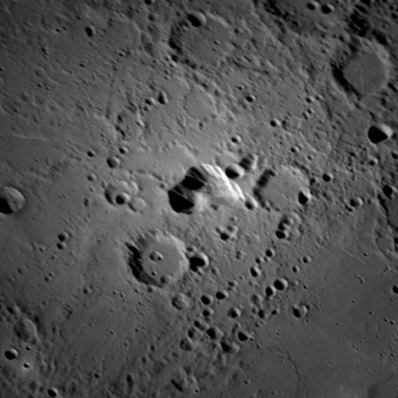
More hidden territory revealed on Mercury
DR EMILY BALDWIN
ASTRONOMY NOW
Posted: November 04, 2009


NASA's MESSENGER spacecraft made its third passage by planet Mercury at the end of September, revealing more secrets about this relatively unknown world.
 Areas of Mercury mapped by Mariner 10 and MESSENGER, leaving only polar regions unimaged. Areas of Mercury mapped by Mariner 10 and MESSENGER, leaving only polar regions unimaged.
Despite a brief power glitch during the flyby, MESSENGER (MErcury Surface, Space ENvironment, GEochemistry and Ranging) collected high resolution images of a further six percent of never before seen terrain, bringing the total to some 98 percent, and leaving only the extreme polar regions to be observed once MESSENGER enters a polar orbit around the planet in 2011.
“Although the area viewed for the first time by spacecraft was less than 350 miles across at the equator, the new images reminded us that Mercury continues to hold surprises,” says principal investigator Sean Solomon.
Some of the surprises included a region with a bright area surrounding an irregularly-shaped depression, which planetary scientists suspect to be volcanic in origin, and another large double-ringed basin. “This double-ring basin, seen in detail for the first time, is remarkably well preserved,” says Brett Denevi, a member of the probe’s imaging team, who reports the crater has an age of around one billion years. “Such an age is quite young for an impact basin, because most basins are about four times older. The inner floor of this basin is even younger than the basin itself and differs in colour from its surroundings. We may have found the youngest volcanic material on Mercury.”
 The bright yellow spot to the upper right in this enhanced colour image is thought to be an area of explosive volcanism. In the centre there is a 290 kilometre wide double-ringed ring basin, which is thought to contain young volcanic material. Smooth plains surround the basin that are thought to represent earlier episodes of volcanic resurfacing.Ê The bright yellow spot to the upper right in this enhanced colour image is thought to be an area of explosive volcanism. In the centre there is a 290 kilometre wide double-ringed ring basin, which is thought to contain young volcanic material. Smooth plains surround the basin that are thought to represent earlier episodes of volcanic resurfacing.Ê
The implication of this discovery is that if the basin is young then the volcanic material is even younger. “After Mariner 10 it was thought that the internal geologic activity on Mercury ended much earlier than on any other planet, and so we are saying that this may not be the case.”
Data was also gathered to assess the surface abundance of iron and titanium. Previous Earth and spacecraft-based observations showed that Mercury’s surface has a very low concentration of iron in silicate minerals, a result that led to the view that the planet’s crust is generally low in iron. In contrast, Mercury's iron-dominated core occupies around 60 percent of the planet's total mass.
“Now we know Mercury’s surface has an average iron and titanium abundance that is higher than most of us expected, similar to some lunar mare basalts,” says mission scientist David Lawrence. “A consequence of these results is that models of Mercury’s formation and evolution are likely going to have to be reassessed to account for the large iron and titanium content. That’s a pretty exciting result for us, it is not something we necessarily expected, and it is going to keep people busy for a while trying to understand this.”
 Detailed view of the irregular depression that appears bright yellow in the image above. It has steep walls, no rim, measures around 30 kilometres across and is surrounded by bright, reflective deposits that likely represent volcanic material. Planetary scientists suspect it may have formed through explosive volcanic activity. Detailed view of the irregular depression that appears bright yellow in the image above. It has steep walls, no rim, measures around 30 kilometres across and is surrounded by bright, reflective deposits that likely represent volcanic material. Planetary scientists suspect it may have formed through explosive volcanic activity.
Once MESSENGER goes into orbit around the planet it will spend at least one year assessing the elemental composition of the surface, to confirm this result and test ideas for evolution of Mercury's core and crust.
MESSENGER also took further measurements of Mercury's thin, tenuous atmosphere – it's exosphere – including the first detailed measurements over the north and south poles.
“A striking illustration of what we call ‘seasonal’ effects in Mercury’s exosphere is that the neutral sodium tail, so prominent in the first two flybys, is 10 to 20 times less intense in emission and significantly reduced in extent,” says Ron Vervack, of the Johns Hopkins University Applied Physics Laboratory. “This difference is related to expected variations in solar radiation pressure as Mercury moves in its orbit and demonstrates why Mercury’s exosphere is one of the most dynamic in the Solar System.”
Studying seasonal variations of the exosphere's constituents, such as sodium, magnesium and calcium, provide key information on the relative importance of the processes that generate, sustain, and modify Mercury’s atmosphere.
MESSENGER has completed nearly three-quarters of its journey to enter orbit around Mercury in March 2011.
|



